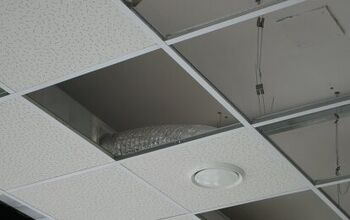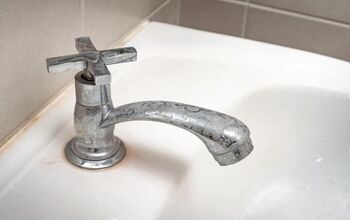How To Remove Water Stains From Ceiling Without Painting

Nothing stands out in a room like a brown water stain on an otherwise beautiful ceiling. You also know how impossible it is to match paint colors. The touchup paint will probably stand out as much as the brown stain. What do you do about water-stained ceilings without resorting to painting?
The primary method of dealing with water stains on ceilings without using paint is bleaching. Many professional restorers use this method. Homeowners can use the same method as well.
Bleaching a water stain is not the only method of dealing with brown stains on a ceiling. However, it is the only one that doesn’t involve painting. We suggest you follow these steps to remove the brown stain on your ceiling before resorting to painting.
Do You Need Wall and Ceiling Cleaning Services?
Get free, zero-commitment quotes from pro contractors near you.

Where Did the Stain Comes From?
That stain didn’t just miraculously appear from nowhere. Brown stains on ceilings are usually the result of a water leak. Before you go any further with a repair, you must find the stain’s source and fix the problem.
The most common sources of water stains on ceilings are from leaking pipes, drains, or roofs. Think of the stain as a symptom of a bigger problem that needs resolving first. Unless you find and fix the source of the stain, you are just postponing bigger problems.
So, before you proceed with removing water stains from your ceiling, you must identify the source of the and correct it accordingly.
Determining the Cause of Ceiling Water Stains
Brown stains on a ceiling are almost always the result of water. As water seeps through the sheetrock or plaster, the minerals in the water cause the stains. As the water sits for a while and begins to evaporate, the minerals are left, causing the stain.
The water may be coming from a leaking pipe or drain or a leak in your roof. In space inadequately ventilated, condensation can form and cause water stains. There may also be a problem with bathroom fixtures. A shower pan can leak water into a lower floor if not properly caulked.
You must find the source of the stain before attempting to remove the stain. If you don’t find the water source, the stain will return and more damage to your home can occur.
1. Plumbing Leaks
If you suspect a plumbing leak, your best bet is to get a plumber in your house. You should consult a plumber if the ceiling stain is on the first floor and you suspect a problem with a second-floor bathroom.
2. Up On the Roof Top
Once you rule out a plumbing leak, the next obvious source of water is a leaking roof. Tracing a leaking roof can be a challenge. Water may run from the roof down joists and rafters many feet before it starts causing a problem. A professional roofer has the skills and knowledge to find the source of the leak and make the necessary repairs.
3. No Leaks? More Ventilation
If there are no plumbing or roof leaks, you should suspect that you have ventilation problems. Enclosed spaces in attics, between floors, and in other confined spaces may be the culprit. A roofer is often a good source of help for these kinds of situations. Your HVAC technician may also be of help in finding the cause of the condensation.
What Kind of Ceiling Do you Have?
The type of ceiling you have and the type of finish on the ceiling are important. Before trying to remove the brown stain from your ceiling, you must know what is under the ceiling’s paint.
If your ceiling finish is plaster, removing the stain from the plaster may be possible. A bleach solution to remove stains from plaster finished walls and ceiling is often the answer.
Sheetrock ceilings, especially those finished with a popcorn surface, pose a different set of problems. The sheetrock may have a skim coat of wallboard mud. The popcorn finish may be part of the paint. If the paint is flaking or peeling, there is virtually no way to make this repair without painting.
If your ceilings finishes are wood, the only way to remove stains is to sand the affected area and then restain and finish the wood to match the surrounding area.
Is Your Ceiling White?
Bleach can and will lighten up paint. So, using bleach to correct ceiling water stains really only works if your ceiling is painted white, or potentially a very light paint color. If you have dark colored ceilings, you can clean with bleach but will have to follow up with paint to completely fix the problem.
Is Your Ceiling Structurally Unchanged?
This solution is really only effective on water stains on drywall, ceiling tiles, or plaster that do not have any other additional damage. If your ceiling has damage other than water stains, you must repair the damage before you can proceed.
A bleach water fix is only for water stains, brown marks, rings, and the like. It will not fix damage. If the plaster, drywall, or paint on your ceiling has started to chip, crumble, fall off, or buckle, you must repair the ceiling first.
How To Remove Water Stains From Ceiling Without Painting
With all of the aforementioned considerations in mind, the best way to remove water stains from your ceiling without using paint is by bleaching. Professional restorers often use this method. Bleaching is easy enough for most homeowners to attempt with success.
Step One: Prepare your materials.
You will need a few supplies to bleach a stain on your ceiling. Get everything together and ready before you begin. You will need:
- Plastic to Cover your Floors and Furniture: You will be working with a bleach solution. You must protect your floors, walls, and furniture from the solution. Cheap painters plastic drops clothes are a good choice. Just remember when it is time to take them up, they may be holding puddles of the bleach solution.
- Protection for You: Long sleeves, rubber gloves, eye protection, and head covering are all important. You will be working overhead with a bleach solution. Protecting yourself is more important than protecting your furniture. Wear safety glasses, appropriate gloves, and other clothing.
- The Bleach Solution: To remove the stain, prepare a bleach solution. Use 1 part bleach to every four parts of warm water. Don’t be tempted to mix the bleach solution stronger. You can damage the plaster or the paint. If your ceilings are colored, chose to use an oxygen bleach rather than chlorine bleach.
- A Good Ladder: Working overhead calls for a good ladder. Trying to bleach your ceiling while standing on a chair or a short stool is asking for trouble. The trouble may only be sore shoulders. However, the trouble could be a nasty fall. Be safe and use the right equipment.
- Sponges: A good sponge is the best method of applying and removing the bleach solution. Natural sponges work best, but some synthetic sponges will stand up to the bleach as well. Get two sponges, one to wipe on the bleach solution and another for rinsing.
Step Two: Bleach the water stain.
Wet one of the sponges with the bleach water solution. Standing on your ladder, carefully wipe the stain with the bleach solution. Do not make the stain exceedingly wet. The idea is to apply just enough bleach solution to dampen the stained area. Give the bleach a few seconds to work.
Note: Avoid scrubbing or rubbing the water stains on your ceilings, as this could damage the paint or ceiling. Then, you’ll have to fix the damaged paint or drywall and create more work for yourself.
Step Three: Rinse and repeat.
After a few seconds, use the second sponge to rinse the area. Use clean, warm water to do the rinse. Keep the sponge clean and just barely damp. The stain should start to lighten visibly. If the first application doesn’t remove the stain, try again.
Step Four: Repeat again, if necessary.
Some stubborn stains may take more than one try. Let the stained area dry completely before trying again. In some cases, it will take 24 hours for the area to dry completely. When the area is dry, try the same process again.
Is the Stain Still Visible?
In some cases, the minerals in the water that caused the stain are more than the bleach can handle. In this case, your only other resort is to paint the ceiling. If you have paint left over from the last paint job, a touchup may be all that is necessary. Before applying the touchup paint, be sure you treat the stained area to prevent the stain from bleeding through the new paint.
How to Stop the Stain from Bleeding Through
For the best results, you need to seal the area of the stain. There are several good products on the market designed specifically to treat and seal stained surfaces before painting. Which product will work best depends on the type of paint used on the ceiling. Consult with a professional painter or the clerk at your paint store for the right product.
Can You Paint Over Water Damage?
As long as it is completely dry and the ceiling or wall is not structurally damaged, you can paint over water damage. In other words, if the only real issue is a water stain or brown ring, you can paint over it. Though, you’ll typically have to paint the entire ceiling to ensure that everything matches.
Unless you know the exact paint color and sheen that was previously used on the ceiling, it may be difficult to find a perfect match. In this case, you can try holding chips up to the ceiling to get a match. Or, pull off a section of the paint and take it to your local home improvement center and ask them to try to match it.
If you decide to paint over ceiling water damage, though, make sure that you use a quality interior latex primer first!
Do You Need Wall and Ceiling Cleaning Services?
Get free, zero-commitment quotes from pro contractors near you.

Wrapping It Up
Repairing and removing a stain on a ceiling may be as simple as a bit of bleach water and a sponge. However, the real trick to keeping your ceilings spotless is to find the problems behind the stains. For the health of your home and your family, remember that a stained ceiling is a symptom. Diagnosing and repairing the real problem is the priority.

Dennis is a retired firefighter with an extensive background in construction, home improvement, and remodeling. He worked in the trades part-time while serving as an active firefighter. On his retirement, he started a remodeling and home repair business, which he ran for several years.
More by Dennis Howard

























![Standard Dining Room Table Dimensions [for 4, 6, 8, 10 and 12 People]](https://cdn-fastly.upgradedhome.com/media/2023/07/31/9074335/standard-dining-room-table-dimensions-for-4-6-8-10-and-12-people.jpg?size=350x220)

